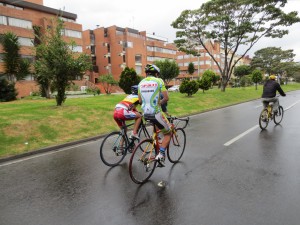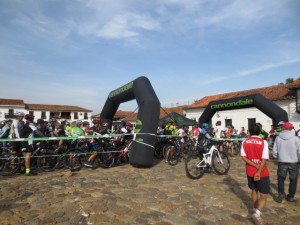 Last week began the Giro d’Italia, one of bicycle racing’s most important international stage events. Colombians are well-represented in the race, and two in particular, Rigoberto Urán and Nairo Quintana, are expected to be top finishers.
Last week began the Giro d’Italia, one of bicycle racing’s most important international stage events. Colombians are well-represented in the race, and two in particular, Rigoberto Urán and Nairo Quintana, are expected to be top finishers.
As of today, Urán is doing very well–he’s in third place–but the race is still young and for weeks commentators here have said they think it will be Quintana who pulls off the win, given his second place finish in last year’s Tour de France and the fact that he and his Movistar team are in tip-top shape.
Quintana is a prominent national figure here, and he fits the classic stereotype of the Colombian racer from humble countryside origins who started riding bikes as transportation and turned into a international bicycle racing sensation. Everyone here knows the prototype. People are especially quick to refer to Lucho “el Jardinerito [Little Gardener] de Fusagasugá” Herrera, the great Colombian pioneer of European racing in the 1980s and early-90s. They almost always observe that he developed his formidable talents, legs, and lungs as a gardener riding to and from his jobs through the mountains outside of Bogotá on a bicycle weighed down with tools. Indeed the gardener with his weed-whacker, rakes, and shovels strapped onto a bicycle is a very common sight here in Bogotá.
Quintana is soft-spoken and timid, grew up in a family of potato and maize farmers in the Department of Boyacá (a department known as especially bicycle-crazy), and got his first bicycle at a young age whereupon he built his stamina and powerful legs as a transportation cyclist running deliveries around the farm and riding to school through Boyacá’s mountainous terrain. In his teens, he began riding with serious sport cyclists, though with casual intentions, and blew everyone away. With training and experience, he has become one of the most formidable escarabajos in Colombian cycling history, escarabajo being a term that means “beetle” and refers to the world-renowned abilities of Colombian racers to climb mountains. Colombia’s best international racers all come from the mountainous regions–Boyacá, Antioquia, Valle del Cauca, and Cundinamarca–and once you see how steep these mountains are, not to mention the high altitudes at which people here ride, it’s no surprise they do so well internationally.
 Bicycling is, according to everyone, Colombia’s second sport, behind soccer. But as one friend here has pointed out, all of Colombia’s glories in international sport come from cycling, not soccer. Here in Bogotá, it’s not unusual to see people riding the streets–during Sunday Ciclovías and on any given weekday in the middle of rush hour traffic–out for a brisk ride on an expensive racing bike and full team kit, evoking the glories of Colombian racers like Quintana. As you leave the city and enter the Cundinamarca countryside, especially during the weekend, the numbers of sport riders surge, as does mountain biking; Colombians have developed a reputation as enthusiastic and highly competitive in mountain biking as well. (The photo here is Colombia’s largest mountain bike race that took place a couple of months ago in Boyacá with 690 participants, most of them from Bogotá.)
Bicycling is, according to everyone, Colombia’s second sport, behind soccer. But as one friend here has pointed out, all of Colombia’s glories in international sport come from cycling, not soccer. Here in Bogotá, it’s not unusual to see people riding the streets–during Sunday Ciclovías and on any given weekday in the middle of rush hour traffic–out for a brisk ride on an expensive racing bike and full team kit, evoking the glories of Colombian racers like Quintana. As you leave the city and enter the Cundinamarca countryside, especially during the weekend, the numbers of sport riders surge, as does mountain biking; Colombians have developed a reputation as enthusiastic and highly competitive in mountain biking as well. (The photo here is Colombia’s largest mountain bike race that took place a couple of months ago in Boyacá with 690 participants, most of them from Bogotá.)
How do these sporting imaginaries relate to the urban cyclist? Obviously I can’t ask the hundreds of thousands of everyday cyclists, nor can I get in other people’s heads. But it’s pretty clear to me that there is no single imaginary of the urban cyclist, or that it necessarily has much to do with sport. For the majority of bicycle users–these being low income men (mostly, though women ride bikes too)–the imaginary of the bicycle is about convenience, saving money, and saving time, of being free of getting stuck in buses or traffic jams that affect getting to and from work, all set against a backdrop of a struggle for a livelihood. For others, many of them young, educated, and new to the bicycle, it is connected to efforts to reimagine Bogotá as a sustainable city (in fact, the city recently won a prize at the World Urban Forum in Medellín last month for, among other ecological initiatives, its promotion of bicycle transportation). For an even smaller number, it’s about associating with transnational urban trendiness and chic fashion. For still others, it is imagining themselves as active and healthy through their participation in recreation. These are not mutually exclusive imaginaries, and they overlap.
 But for some it’s clear that the prominence of Colombia’s competitiveness in bicycle sport gives important symbolic significance and legitimation to their everyday practice of getting around. As a friend involved in bicycle activism observed, “Although riding as an urban cyclist isn’t sport, there’s a tie many of us feel to this history and its glories. It gives you passion and can help you in certain moments. It’s the same heart, the same feeling.”
But for some it’s clear that the prominence of Colombia’s competitiveness in bicycle sport gives important symbolic significance and legitimation to their everyday practice of getting around. As a friend involved in bicycle activism observed, “Although riding as an urban cyclist isn’t sport, there’s a tie many of us feel to this history and its glories. It gives you passion and can help you in certain moments. It’s the same heart, the same feeling.”
The lines between the imaginaries of urban transportation cycling and sport, in other words, can blur here. As one of my informants recounted to me, Nairo Quintana himself said in an interview that drivers need to recognize that the next time they cut off a cyclist they might be cutting off a future champion. The bicycle, Quintana said, should be given the status it deserves, whose potential for transportation and sports are equally important to Colombians.